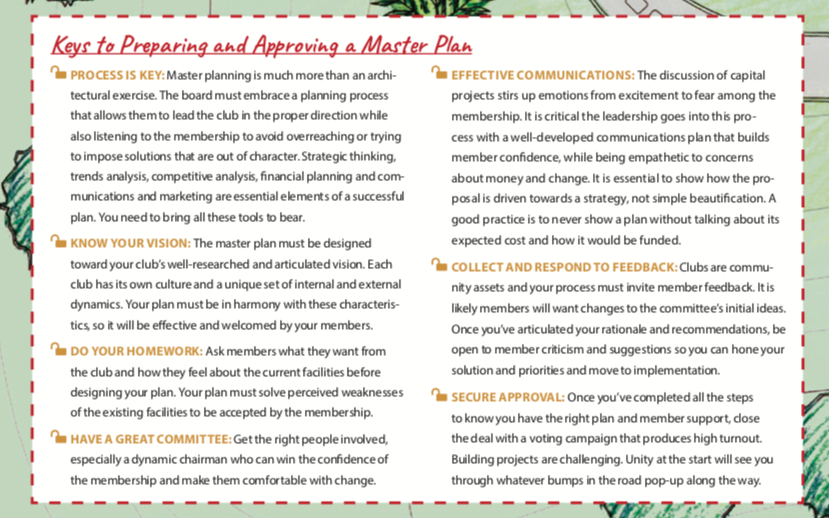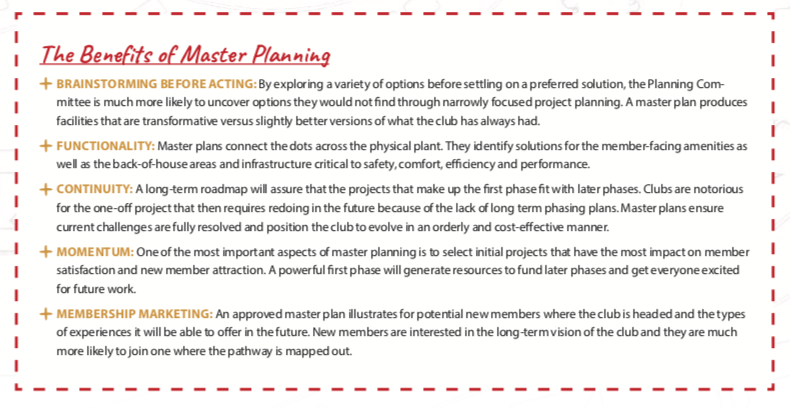A core principle of club membership has long been exclusive access to premier facilities. These days, when perceived value is a distinguishing characteristic for clubs and activity preferences are changing dramatically, it is arguable that a club’s physical facilities are more important to their success than ever before. Given this changing landscape, developing a master plan is one of the most important steps club leaders can take to position their club for success and growth.
When clubs were once only looking to become a fresher version of their historic selves, it was acceptable to work through projects here and there across the campus. There is a critical difference between narrowly targeted improvement projects and master plans, however. The former looks only to improve an asset in its present form or place, while a master plan probes deeper questions of shifting values and the relative importance of new or different activities. It is the pathway to transformative investments that positions the club for the long run.
No matter the type—city, country, yacht or other—the club of the future will be a multi-faceted collection of social spaces and recreational activities. It will offer a diverse set of features and benefits where innovative leaders can initiate programs that increase member engagement. These facilities must work in unison to deliver the proper member experience as well as avoid competition within the offering or require an inordinate amount of labor.
The master planning process starts with a solid understanding of the club’s mission and vision. This central agreement on the experience the club must offer is typically the responsibility of the board and provides the direction the planners require to develop an effective plan. Survey work was likely part of the initial visioning process, but if not, then a targeted facilities survey should be administered by the Planning Committee. This team will also need to study the external environment, including the changing nature of the membership experience and the benefits clubs are deriving by adding facilities for families, exercise and fun and games.
Master plans are also more important these days because clubs are trying to do so much with their facilities. This makes for a more diverse set of users and activity patterns. It is increasingly common for a club to offer active athletics like fitness, tennis and pickleball and expansive pool complexes and a diverse set of social and dining venues. These investments are adding value to the member experience, so members and their families can use the club more frequently and in different ways. This makes it more important than ever to clarify spatial relationships and establish circulation patterns that promote harmony between the different user groups. To properly accommodate these growing demands, it is important to think through how your facilities will balance adult and family use, casual to formal dress and new active athletics and traditional sports.

Continually Expanding the Circle of Involvement
Developing and receiving member approval to invest their money to improve the club’s facilities is the result of a thoughtful process that engages the broader membership. Clubs often miss the point here, first viewing this as solely an architectural exercise. While the facility solution is obviously important, it is only one aspect of a multi-layered process that includes strategy, financial planning, communications and marketing, and yes, basic politics. Club leaders must approach planning as a holistic process or they will fail to strike the right vision and receive member endorsement to move ahead with the vital first phase.

Your planning program should be led by a committee that includes a mix of club leaders and at-large members from different age and interest groups. They will steer the process and interact with your planners to complete the initial research, link the plan to the club’s strategy, establish goals and program requirements and, ultimately, produce a preliminary plan. Beyond this obvious requirement, it is critical that the entire membership can participate in the review and finalization stages. Plans handed down from the top are typically rejected by members because they feel imposed rather than organic. For a plan to address the membership’s top priorities and receive broad support, it is essential all members are given the opportunity to attend meetings, view video presentations, read project booklets and other information on the plan section of the club’s website and, most important of all, be invited to participate in a formal feedback loop before preliminary ideas go final. This feedback should cover the key aspects of the proposal, including the priority of the projects and the financial plan. A broad member review will not only assure the wisdom of the membership is baked into your final proposal, it will also generate the goodwill toward the recommendations that is critical to approval.


Bright Prospects Ahead
It is an exciting time for clubs. For the first time since the 1980s, the number of people moving into the prime joining years will increase each year for the next decade. Clubs have historically performed well when these age waves occur. Additionally, the credit markets are awash in capital looking for sound investments. Clubs with strong balance sheets and cash flow have greater access to capital and the ability to structure favorable long-term deals that can change their approach to facility reinvestment and enhancement. A master plan is a critical tool for maximizing this potential and creates the physical plant clubs need to satisfy the members they have and attract the next generation.
Frank Vain is president of McMahon Group, Inc., a premier full-service, private club consulting firm serving more than 2,000 private clubs around the world. He serves as NCA Chairman. He can be reached at [email protected].



